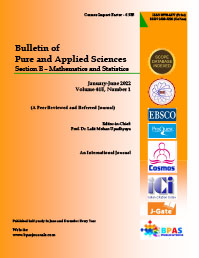Recognizing emotions using elementary hyperedges in intuitionistic fuzzy soft hypergraphs ∗
DOI:
https://doi.org/10.48165/Keywords:
Intuitionistic fuzzy soft hypergraphs(IFSHGs), Core, Simple, Support Simple, Elementary and Sectionally elementary IFSHGs, (µ, ν)-tempered IFSHGAbstract
In this paper, we introduce the notion of intuitionistic fuzzy soft hyper graphs(IFSHGs), certain types of IFSHGs including core, simple, elementary, sectionally elementary, (µ, ν)-tempered (IFSHGs) are dealt with examples. Also this concept is an alyzed in emotion recognition as an application too.
References
Akram, K. and Dudek, W.A. (2013). Intuitionistic fuzzy hypergraphs with applications, Informa tion Sciences, 218(1), 182–193.
Akram, K. and Nawaz, S. (2015). On fuzzy sets, Italian Journal of Pure and Applied Mathematics, 34, 497–514.
Atanassov, K.T. (1986). Intutionistic fuzzy sets, Fuzzy Sets and System, 20(1), 87–96. [4] Atanassov, K.T. (2012). Intutionistic Fuzzy Sets: Theory and Applications, Studies in Fuzziness and Soft Computing; Physica-Verlag, Heidelberg, Germany.
Berge, C. (1976). Graphs and Hypergraphs, North Holland, New York.
Karunambigai, M.G. and Parvathi, R. (2006). Intutionistic fuzzy graphs, Journal of Computational Intelligence: Theory and Applications, 20, 139–150.
Mathew, T.K. and Shyla, A.M. (2019). Some properties of intutionistic fuzzy soft graph, Interna tional Journal of Mathematics and Applications, 7(2), 59–73.
Maji, P.K., Roy, A.R. and Biswas, R. (2004). On intutionistic fuzzy soft sets, The Journal of Fuzzy Mathematics, 12(3), 669–683.
Maji, P.K., Biswas, R. and Roy, A.R. (2003). Soft set theory, Computational Mathematics and Applications, 45 (4–5), 555–562.
Mohinta, S. and Samanta, T.K. (2015). An introduction to fuzzy soft graph, Mathematica Morav ica, 19(2), 35–48.
Molodstov, D. (1999). Soft set theory-first results, Computers and Mathematics with Applications, 37 (4), 19–31.
Moderson, J.N. and Nair, P.S. (2000). Fuzzy Graphs and Fuzzy Hypergraphs, Physica-Verlag, Heidelberg, Germany.
Myithili, K.K., Parvathi, R. and Akram, M. (2016). Certain types of intutionistic fuzzy directed hypergraphs, International Journal of Machine Learning and Cybernetics, 7(2), 287–295. https: //doi.org/10.1007/s13042-014-0253-1
Nagoor Gani, A. (2010). Degree, order and size in intutionistic fuzzy graphs, International Journal of Algorithms, Computing and Mathematics, 3(3), 12–16.
Parvathi, R., Thilagavathi, S. and Karunambigai, M.G. (2009). Intutionistic fuzzy hypergraphs, Cybernatics and Information Technologies, 9(2), 46–53.
Rosenfeld, A. (1975). Fuzzy Graphs, Fuzzy Sets and Their Applications, Academic Press, New York, USA, 77–95.
Shahzadi, S. and Akram, M. (2018). Graphs in an intutionistic fuzzy soft environment, Axioms, 7, 2–16.
Thumbakara, R.K. and George, B. (2014). Soft Graphs, General Mathematics Notes, 21, 75–86. [19] Zadeh, L.A. (1965). Fuzzy sets, Information Control, 8, 338–353.
